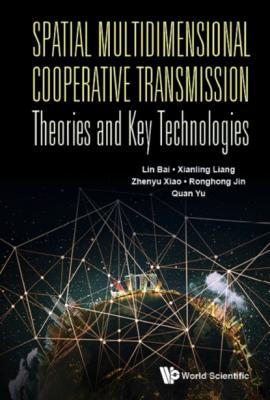Spatial Multidimensional Cooperative Transmission Theories And Key Technologies. Lin Bai
Читать онлайн.| Название | Spatial Multidimensional Cooperative Transmission Theories And Key Technologies |
|---|---|
| Автор произведения | Lin Bai |
| Жанр | Зарубежная компьютерная литература |
| Серия | |
| Издательство | Зарубежная компьютерная литература |
| Год выпуска | 0 |
| isbn | 9789811202476 |
In a wireless communication system, utilizing a certain technology to obtain multiple copies of the same source signal at the receiving end can effectively improve the reliability of signal transmission, such as the multi-antenna receiving technology mentioned above, or repeatedly transmitting the same signal several times at the transmitting end. If each signal passes through different channels during transmission and arrives at the receiving end with different receiving states, then the received signal strength of each signal which is expressed in Eq. (2.1) will be quite different. In other words, the signal-to-noise ratio of these received signals is different. If the received signals are represented by the respective corresponding vectors in the vector space, then according to mathematical derivation, the total signal strength will increase as the vector space dimension increases, although the signal strength may become weak in a certain dimension.
In the actual production process, the channel gain between the transmitter and the receiver is affected by many factors such as transmission distance and multipath propagation. The transmission distance determines the average gain of the channel, while multipath propagation and the motion of the transmitter and receiver affect the instantaneous channel gain. In addition, moving the obstacles between the transmitter and the receiver can also result in time-varying channel gains. Due to the influence of various factors, the channel in wireless communication system is often a fading channel. In the fading channel environment, the signal-to-noise ratio (SNR) can be regarded as a time-varying random variable. However, when the SNR is below a certain threshold, the receiver cannot detect the signal. Therefore, we should try to reduce the probability that the SNR is lower than the threshold, namely reducing the probability of interruption. To solve this problem, we can use multi-receiving antenna diversity technology to reduce the probability of interruption, so as to obtain better signal detection performance. The gain obtained from this diversity is called the spatial diversity gain.
We call the vector space of the received signal as Space Domain, and the channel gain generated by the multidimensional signal (or multiple copies of the same signal) is known as the spatial diversity gain. In what follows, we will focus on several ways of combining signals in a wireless communication system.
2.1.1.1The combining method of known channels
Based on the models expressed in Eqs. (2.2) and (2.3), when the channel state information h is known, the signal combination method can be designed separately according to the optimal discriminant criteria of different linear combination vectors w. In the following, the combination methods of received signals such as the minimum mean square error, the maximum SNR, the maximum likelihood estimation, the maximum ratio, and the general selection diversity will be introduced.
(1) Minimum mean square error combining
The minimum mean square error algorithm determines the combining signal vector w by minimizing the mean square error between the transmitted signal s and a linear combiner output.
If the signal and noise both obey Gaussian distribution, then the ideal MMSE combination is also a linear MMSE combination. In order to implement the linear MMSE combination algorithm, the statistical properties of h, s, and n need to be known first. It is generally assumed that
The output of the linear combiner, namely the MSE of signal s and its estimated value
It is easy to know that the MSE is a function of vector w. According to the orthogonality principle, the optimal combining vector is
where Rr = E(yyH) is the covariance matrix of the received signal vector y and c = E(ys*) is the correlation vector of vectors y and s*. If s and n are not related, then
where
Therefore, MMSE is
It can be seen from Eq. (2.7) that the value of MMSE depends on the transmitted signal s, the channel transmission vector h, and the noise covariance matrix Rn. Taking the extreme value as an example, when
Substituting Eq. (2.7) into Eq. (2.6) we get
substituting Eq. (2.8) into Eq. (2.3), we can obtain the estimated signal based on MMSE.
where,
(2) Maximum SNR combining
If the criterion for maximizing SNR is used in the linear combination, then for the combined vector w, the combined signal can be written as
where the first item and the second item on the right-hand side are the signal and noise, respectively. Thus, the SNR is given as follows:
where the full rank covariance matrix Rn must be a positive definite matrix (matrix decomposition
and then the combined vector
